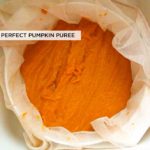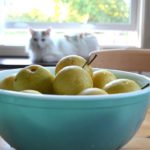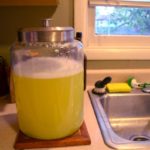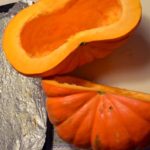Here is the excerpt from Euell Gibbons on his method, which he originally wrote for Organic Gardening:
 Naturally, I got started at this tasty sport with wild foods. A nearby path of wild Jerusalem artichokes had yielded a bumper crop, and I wanted to preserve some. I used a gallon-size glass jar, getting all of these jars I wanted from a nearby school cafeteria.
Naturally, I got started at this tasty sport with wild foods. A nearby path of wild Jerusalem artichokes had yielded a bumper crop, and I wanted to preserve some. I used a gallon-size glass jar, getting all of these jars I wanted from a nearby school cafeteria.
Packing a layer of dill on the bottom of the jar, I added several cloves of garlic, a few red tabasco peppers, then some cored and peeled Jerusalem artichokes, plus another layer of dill. With room still left, I looked around for other things to add. The winter onions had great bunches of top sets, so I peeled a few and made a layer of them. Then I dug up some of the surplus onions and used the bottom sets – shaped like huge cloves of garlic – to make still another layer. I then put in a layer of cauliflower picked apart into small florets, and added some red sweet pepper cut in strips, along with a handful or so of nasturtium buds.
This was all covered with a brine made by adding three-fourths of a measure of salt to 10 measures of water. I added some cider vinegar too, but only 1/4 cup to the whole gallon. I topped the whole thing with some more dill, set a small saucer weighted with a rock on top to keep everything below the brine, and then let it cure at room temperature.
After 2 weeks I decided it must be fin¬ished. The Jerusalem artichokes were superb, crisp and delicious. The winter onions, both the top and bottom sets, were the best pickled onions I ever tasted. The cauliflower florets all disappeared the first time I let my grand¬children taste them, while the nasturtium buds make better capers than capers do.
The next summer I determined to get started early and keep a huge dill crock running all season. Any size crock can be used, from 1 gallon up. I use a 10-gallon one and wish it were bigger. Never try to use a set recipe for a dill crock, but rather let each one be a separate and original “creation.” I plant plenty of dill, and keep planting some every few weeks so I’ll always have some on hand at just the right stage.
What is good in a dill crock? Nearly any kind of firm, crisp vegetable. Green beans are perfect, and wax beans also very good. These are the only two things cooked before being added to the brine, and they should be cooked not more than about 3 minutes. And small green tomatoes are great. Nothing else so nice ever happened to a cauliflower. Just break the head up into small florets, and drop it into the dilled brine. In a week or two-the finest dilled cauliflower pickle ever tasted.
If you have winter onions, clean some sets and put them in the crock. It’s a tedious job, but the results are worth it. Not only do they add to the flavor of all the rest of the ingredients in the jar, but the little onions themselves are superb. If you don’t have win¬ter onions, you can sometimes buy small pickling onions on the market and use them. If not, just take ordinary onions and slice them crosswise into three or four sections. These will come apart after curing, but so what? They are simply great pickled onion rings. I’ve even cut off the white part of scal¬lions and thrown them in the brine, with some success, and one late-fall dill crock was fla¬vored with white sections of leek, which did it wonders.
To preserve these pickles, pack them in hot, scalded quart jars along with some fresh dill. Strain the brine, bring to a boil, and pour over pickles, leaving 1/2-inch headspace. (You can also make new brine using 1/2 cup salt and 4 cups vinegar to 1 gallon water, but the old brine is much more flavorful.) Seal and process in a boiling-water bath for 25 minutes.
 The idea of this lovely container sitting on the counter with colorful vegetables exchanging flavors over several weeks was motivating enough for me to run out that very night and make my own. We bought a few veggies and add some from our own garden. In the end, ours is layered from bottom to top as follows:
The idea of this lovely container sitting on the counter with colorful vegetables exchanging flavors over several weeks was motivating enough for me to run out that very night and make my own. We bought a few veggies and add some from our own garden. In the end, ours is layered from bottom to top as follows:
- dill flowers
- garlic cloves
- carrots
- cauliflower
- cucumber
- walla walla onion
- green beans
- red bell pepper
- asparagus
Reading this small excerpt by Euell Gibbons has also motivated me to read more of his literature. He was before my time, but sounds very influential to the wild foods movement, something I have long been curious about.
My plan with this dill crock is to let it age 3 weeks, then can into smaller containers. I ended up buying a two gallon jug, so I will end up with a heap of canned versions. If all goes well, I plan to layer the veggies as they currently are and give several away as gifts. Hope it works out!




 Upgrade your hanging basket game!
Upgrade your hanging basket game!  Here’s
Here’s

 This cluster was about the siz
This cluster was about the siz



 I start with a
I start with a


I helped my mother make this in the late 70’s and we devoured it like wolves! I just found her old Stocking Up cookbook and a friend recently planted dill and doesn’t know what to do with it. I do! I’m cleaning the dog food out of my crock and using Euell’s wonderful recipe. Try it yourselves.
My husband and I did this crock about 10 years ago and the original recipe said if you canned it that the brine should be made fresh so it is clear and looks pretty in the jar. We did this and it was wonderful!